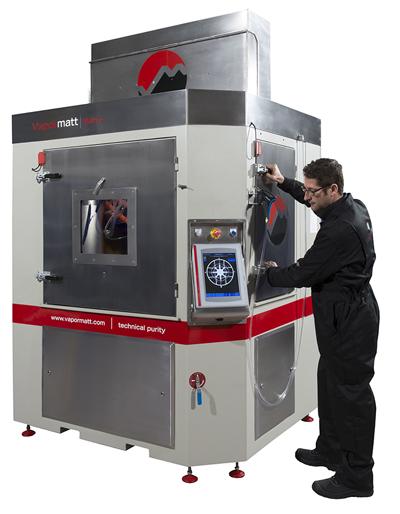
Vapormatt has announced that its Sabre wet blasting machine has been installed at coating specialist Ionbond's demonstration centre in Switzerland. Ionbond, one of the largest providers of hard, wear resistant and low friction coatings, offers PVD, CVD and PACVD services and equipment worldwide. The demonstration centre features best-in-class equipment, and therefore further underlines Vapormatt's position as an industry leading provider of edge preparation and precoating technologies for cutting tools.
Joe Haggerty, CEO at Ionbond, commented: "Wet blasting is the preferred option for deburring and surface finishing for coating specialists. Vapormatt's Sabre enables excellent controllability and reproducibility during the process. This is essential in aerospace, medical and tooling manufacture where quality needs to be both consistent and measurable. For this reason it is only fitting that the Sabre joins other innovative and industry-leading technology as a valued addition of our demonstration centre."
The Sabre was developed in response to high customer demand to serve three new user groups, offering small to medium volume manufacturers, coating centres and R&D facilities a cost-effective, high performance wet blasting system to significantly enhance tool life through edge preparation and precoating processes.
The unique nozzle arrangements of the Vapormatt Sabre focuses blast guns on the critical faces and cutting edges, delivering consistent and controllable results. This ensures total coverage of tools, offering edge radii within +/-5µm tolerance of specification and a HF1 surface finish that will dramatically improve coating adhesion. With the option to fit both Y and X axis nozzle arrangements the Sabre not only offers great customisation for the user but also provides hybrid functionality, making it possible to process round shank tools to hobs and saw blades to cutting inserts in one system.
Contact Details
Related Glossary Terms
- chemical vapor deposition ( CVD)
chemical vapor deposition ( CVD)
High-temperature (1,000° C or higher), atmosphere-controlled process in which a chemical reaction is induced for the purpose of depositing a coating 2µm to 12µm thick on a tool’s surface. See coated tools; PVD, physical vapor deposition.
- edge preparation
edge preparation
Conditioning of the cutting edge, such as a honing or chamfering, to make it stronger and less susceptible to chipping. A chamfer is a bevel on the tool’s cutting edge; the angle is measured from the cutting face downward and generally varies from 25° to 45°. Honing is the process of rounding or blunting the cutting edge with abrasives, either manually or mechanically.
- physical vapor deposition ( PVD)
physical vapor deposition ( PVD)
Tool-coating process performed at low temperature (500° C), compared to chemical vapor deposition (1,000° C). Employs electric field to generate necessary heat for depositing coating on a tool’s surface. See CVD, chemical vapor deposition.
- sawing machine ( saw)
sawing machine ( saw)
Machine designed to use a serrated-tooth blade to cut metal or other material. Comes in a wide variety of styles but takes one of four basic forms: hacksaw (a simple, rugged machine that uses a reciprocating motion to part metal or other material); cold or circular saw (powers a circular blade that cuts structural materials); bandsaw (runs an endless band; the two basic types are cutoff and contour band machines, which cut intricate contours and shapes); and abrasive cutoff saw (similar in appearance to the cold saw, but uses an abrasive disc that rotates at high speeds rather than a blade with serrated teeth).
- shank
shank
Main body of a tool; the portion of a drill or similar end-held tool that fits into a collet, chuck or similar mounting device.
- tolerance
tolerance
Minimum and maximum amount a workpiece dimension is allowed to vary from a set standard and still be acceptable.
